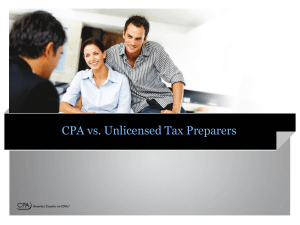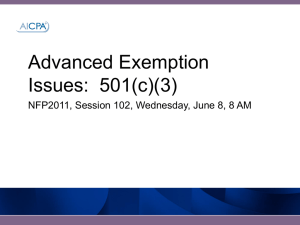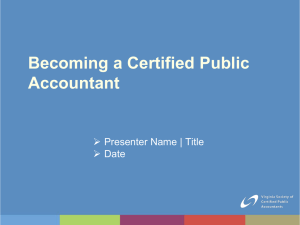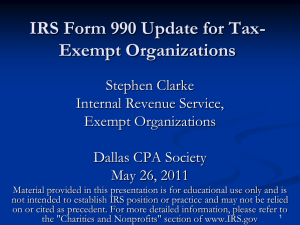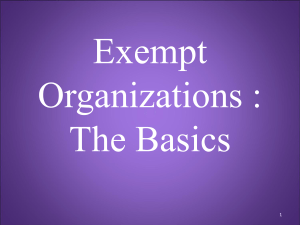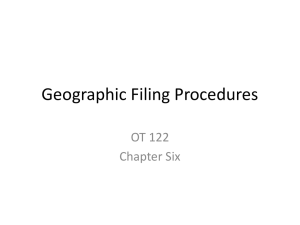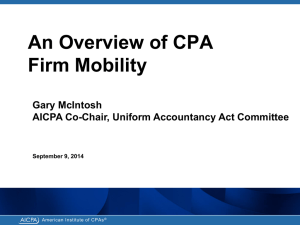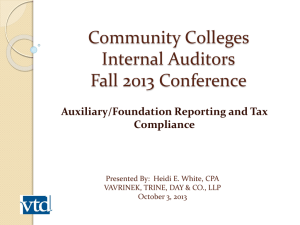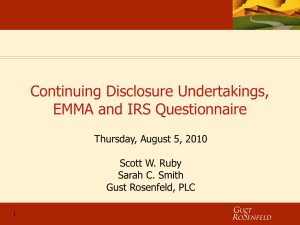NFP11-Sess-60-Gettin..
advertisement
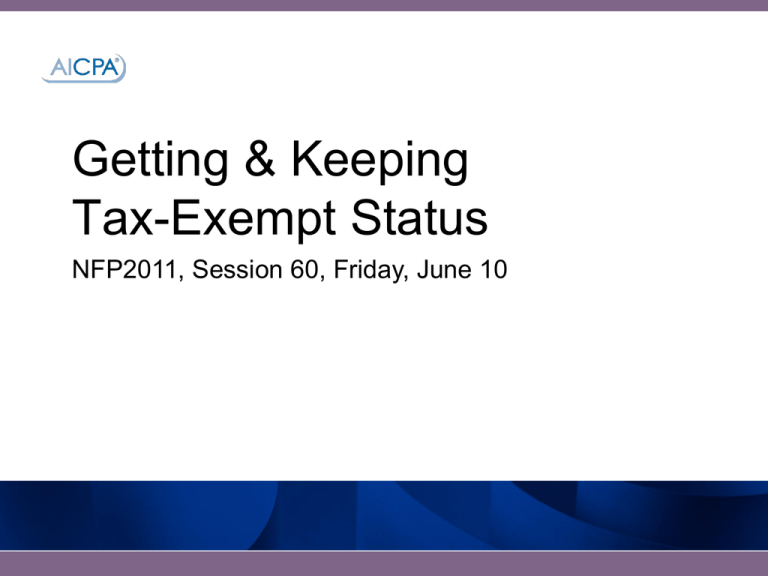
Getting & Keeping Tax-Exempt Status NFP2011, Session 60, Friday, June 10 Speaker Biography TERRY MILLER brings years of training and consulting experience in the nonprofit sector across a broad range of organizations. His passion is making information accessible to nonprofit managers, boards and advisors. He received his B.A. from Antioch College in Yellow Springs, Ohio in 1977, and his M.B.A. from the University of Portland in 1984. Terry balances consulting with his work as Finance Manager for River Network, a Portland, Oregon based environmental organization working to strengthen local watershed group nationally. TERRY MILLER www.TerryMiller.biz Terry@TerryMiller.biz 62 Rudden Ave San Francisco California 94112-2540 voice: 415-333-6320 fax: 415-333-6309 American Institute of CPAs Session Overview Today: Focus on mechanics Today: Interactive – your experiences too “Organized and Operated” “exclusively for” Application not always required? Really? Procedures to file for smooth filing 1023/1024 What to expect from IRS / how to shepherd How to KEEP exemption: what not to do Additional resources American Institute of CPAs 3 Section 501(c)(3) …in its entirety (color added) “(3) Corporations, and any community chest, fund, or foundation, organized and operated exclusively for religious, charitable, scientific, testing for public safety, literary, or educational purposes, or to foster national or international amateur sports competition (but only if no part of its activities involve the provision of athletic facilities or equipment), or for the prevention of cruelty to children or animals, no part of the net earnings of which inures to the benefit of any private shareholder or individual, no substantial part of the activities of which is carrying on propaganda, or otherwise attempting, to influence legislation (except as otherwise provided in subsection (h)), and which does not participate in, or intervene in (including the publishing or distributing of statements), any political campaign on behalf of (or in opposition to) any candidate for public office.” American Institute of CPAs 4 Section 501(c)(4), (c)(5) & (c)(6) …in their entirety (color added) “(4) (A) Civic leagues or organizations not organized for profit but operated exclusively for the promotion of social welfare, or local associations of employees, the membership of which is limited to the employees of a designated person or persons in a particular municipality, and the net earnings of which are devoted exclusively to charitable, educational, or recreational purposes. (B) Subparagraph (A) shall not apply to an entity unless no part of the net earnings of such entity inures to the benefit of any private shareholder or individual. (5) Labor, agricultural, or horticultural organizations. (6) Business leagues, chambers of commerce, real-estate boards, boards of trade, or professional football leagues (whether or not administering a pension fund for football players), not organized for profit and no part of the net earnings of which inures to the benefit of any private shareholder or individual.” American Institute of CPAs 5 “Organized and Operated” “exclusively” “Organized” = required language in the Articles of Incorporation, trust document, or other charter • Articles of Incorporation get filed with State government and amendments must be filed; States have their own rules • “Irrevocable dedication” clause for charities is required to get tax exemption • Dissolution clause is also required - C3: remaining assets to another C3 - C4: remaining assets to another C4 or C3 - C5 & C6: remaining assets may also go to members “Operated exclusively” = ? • In practice, “exclusive” means that all other purposes / activities added together must not be “substantial” (ah, tax lawyers!) • Often substantial is equated to >20%, but is NOT bright line American Institute of CPAs 6 Application required? 1/2 Form 1023 is called “Application for Recognition of Exemption Under Section 501(c)(3) of the Internal Revenue Code” Form 1024 is called “Application for Recognition of Exemption Under Section 501(a)” • This means for recognition under 501(c)(2,4,5,6,7,9,10,11,12, 13,15,17,19 or 25) To be tax exempt under any of these sections must be operated exclusively for those purposes from inception American Institute of CPAs 7 Application required? 2/2 If you: • open a bank account and operate first, and incorporate sometime later, • IRS will theoretically treat those as two entities: two applications due, need two EINs - In practice, I have seen them more than once grant recognition as a single entity back to opening of account The first lesson is: incorporate and get an EIN (via Form SS-4, can be done online) FIRST Then “perfect” the corporation (bylaws & board), THEN apply for recognition of exemption Application is NOT required from: 501(c)(3)s which will be below $5,000 in annual gross receipts, nor from other 501(c) organizations … Say what? CATCH-22: as soon as you file a 990 they will write and say “thanks, but who are you? please submit Form 1023/1024” • Anyone have this direct experience recently? (I am waiting on one.) American Institute of CPAs 8 Filing the TEA Jargon alert: “TEA” = Tax Exemption Application First tip: file sooner rather than later, don’t procrastinate! • Facts are often trickier than good intentions and representations • (Note that they do flag some applications for review of actual operations in a few years) Filing deadline? • 501(c)(3): 27 months from inception • 501(c)(other): no deadline If (c3) file by deadline, recognition will be retroactive to inception (provided been “operated exclusively” for) If (c3) miss deadline, usually only recognition back to filing date of TEA • Unless reasonable cause is demonstrated. • Anyone managed to pull this off? American Institute of CPAs 9 Life before recognition 1/2 What to do in the meantime after filing, while waiting? • If actually operating, make sure to “operate exclusively for” • For 501(c)(3) charities, where it is often necessary to show an IRS recognition letter in order to attract gifts, consider a “fiscal sponsorship” - Fiscal Sponsorship is another matter entirely, and should not be called “fiscal agency” “conduit” “renting their C3” “using their C3” “pass-through” or any number of other words - Two main models: 1) nascent charity operates as a direct program of sponsor, 2) sponsor agrees to make grants to the new organization, usually a nonprofit “organized and operated for charitable purposes which has not yet received recognition” (this feels like a pass-through • For 501(c)(4,5,6…) just start, but make sure to be properly “organized” and to “operate exclusively” for your exempt purposes And don’t wait! MUCH better to apply early. American Institute of CPAs 10 Life before recognition 2/2 Can someone make a tax-deductible gift to the new 501(c)(3) in the time before it is recognized? - Yes, but you cannot give them a receipt, and if your TEA fails they may have to amend their return to UNdeduct the gift - Foundations & corporations will not do this, generally, so you will be left with “friends & family” donations - Why can another charity make grants to us if foundations will not? - Part of being a public charity is that it is legal to make a grant to any entity for specific charitable purposes - But many of them would rather your new charity operate as their program rather than trying the fancy regranting model Do we have to have the corporation “perfected” to file? • Not technically, only “organized” (Articles filed), but the Bylaws contain such key indicators of narrow vs. community control, that it will be much smoother to finish the setup first • If necessary while recruiting a Board, you can set up with an “initial” Board of three or so, and explain it accordingly American Institute of CPAs 11 The TEA Package We have Articles, Bylaws & Board, what’s in the application? • Cover letter describing each attachment • Form 1023 or 1024 (1023 has a handy checklist and order of assembly) • Filing Fee Check (with Form 1024, this takes Form 8718 to carry check) • Narrative description of proposed program activities & fundraising plans (how and from who?) • Proposed three-year budget, or 3-year mix of “actual” & budget • List of Directors and Officers (these are NOT the same thing) • Form 2848 “Power of Attorney” if a lawyer or accountant will file and be able to speak for you • Form 5768 for 501(c)(3)s that will advocate on public policy (it’s a lobbying “election” of a more clear test) • Articles, Bylaws, Conflict of Interest pol, clippings, fundraising appeals • Membership terms / prices (if any) Send it by Express Mail or FedEx just for security’s sake American Institute of CPAs 12 Process (Tips) for a Smooth Filing 1/5 Some basics • Neat, type-written, grammatically correct and without spelling errors indicates likely good stewardship • Put EIN at top of every single page • Use a cashiers check • Unless you are certain you will be super-tiny (in which case you may not need to file at all), pay the higher $850 fee, not the $400 fee • The Articles of Incorporation may be a photocopy but should be a photocopy of the “file-stamped” Articles showing the State Government’s stamp and date filed (this is the date of inception) • The Bylaws should have a final page signed by the corporate Secretary certifying that they were adopted by the Board on xx/xx/xx date (known as “Certificate of Secretary”) • For publicly supported 501(c)(3) applications there is a confusing section (replaces the old Form 872-C) in the form – statute of limitations waiver on investment income tax payable by private foundations - just sign it American Institute of CPAs 13 Process (Tips) for a Smooth Filing 2/5 Some basics • The proposed budget is often a huge stumbling block and causes tremendous delays, for no good reason - The budget is NOT binding; they are looking for something which resembles what you’ve said in the narrative - It is often helpful to ignore their budget page and attach a neat summary spreadsheet - For payroll, it is helpful to indicate numbers of staff, highest paid staff in the budget (even if all prospective) and if the compensation will be high, say over $100K, then start to think about showing bios and qualifications and so forth - With payroll and consultants it is helpful to represent that you will not pay amounts that are more than comparable-comparablecomparable (skills / qualifications / duties / organizations) - It is helpful to footnote any particularly high costs: travel etc, and to footnote consultants to indicate that people doing the work of employees will not be paid as consultants American Institute of CPAs 14 Process (Tips) for a Smooth Filing 3/5 Questions & experiences with these details so far? Program Narrative • Be as complete and as specific as possible • Start at the BEGINNING, explain everything, do not assume the IRS reviewer understands the problem you want to solve, avoid jargon or define it carefully - Ask a friend or relative to read it and see if they understand what you plan to do • Include ideas that you may or may not pursue: “While we have no specific plans, future program options could include ….” • Keep in mind the “Big Four” tax exemption issues we will discuss later • Do not hide sticky details – better to work them out now and get a stronger “license” – anyone can get exemption for a generic “all good things” but if it’s not what you really do later, that’s asking for trouble American Institute of CPAs 15 Process (Tips) for a Smooth Filing 4/5 Fundraising Narrative • For most publicly supported 501(c)(3)s they want to hear about a wide range of fundraising plans • If you intend to use a professional fundraiser (defined very broadly as anyone doing it for a fee vs. staff and volunteers), explain the relationship and know that working for a % of what is raised is generally frowned upon (sounds like sharing profits) • Earned income strategies are all the rage, but need to take care that they do not indicate a commercial purpose rather than a charitable purpose - Selling below cost is always a good charitable indicator - Sliding scales are good - If there are businesses that do what you plan to do you should think about it American Institute of CPAs 16 Process (Tips) for a Smooth Filing 5/5 Tax Exemption: a few words on the “Big Four” • Commerciality • Politics & Lobbying • Private Inurement • Private vs. Public / Charitable Benefit These are all areas where you want to be aware of the issue, but not hide any sharp edges, better to get them out there; if IRS has questions, they’ll ask American Institute of CPAs 17 Shepherding the Application 1/5 The big question: how long will it take? This is tax law, so the answer is always the same: “depends on facts and circumstances” • Also depends on time of year (many applications filed right at beginning of year) and • IRS’ staffing issues (like other organizations, raft of retirements / baby boom) Short answer: either fast, 30 days, or 4-12 months American Institute of CPAs 18 Shepherding the Application What happens to the application at IRS? 2/5 1/4 • When they receive it, immediate senior review: about half will clear on the spot (501(c)(4)s, private foundations, and very vanilla community theatre type arts groups) • Others will be put into a pile for routing to a specialist to review - Especially internet, public policy advocacy, and nearly commercial • IRS will mail an acknowledgement and saying to expect an answer in a certain period (was 120 days for a time). - Any experiences with this lately? • You can look up the application online now and see where it is in the process (and who it has been assigned to) - Anyone have experience with this? American Institute of CPAs 19 Shepherding the Application What happens to the application at IRS? 3/5 2/4 • After it’s been on a reviewer’s desk for 90 days, it is good to leave a friendly voicemail asking about status and offering help, giving a phone number (they are more likely to write) • If you need to call “EO Customer Service” (1-877-829-5500), they are in Cincinnati and you should call EARLY in the day to avoid long hold time • Calls require an officer or a signer on the Power of Attorney American Institute of CPAs 20 Shepherding the Application What happens to the application at IRS? 4/5 3/4 • The reviewer (rarely) approves them at this stage, (usually) asks written questions, and (rarely) refers it straight to national office - Written questions will give you a sense of their concerns, and can range from one or few stupid questions to two pages of single-spaced highly critical questions - If the questions make you roll your eyes, that’s actually a good sign that the person is just showing their boss they’re doing their job (sort of) and you just need to repeat the answers you probably gave already - If the questions are long and critical and you’re D-I-Y you may want to get counsel ASAP before getting in deeper - Answer the questions precisely and exactly, one by one, clause by clause, in the exact order asked; do not answer the general thrust American Institute of CPAs 21 Shepherding the Application What happens to the application at IRS? 5/5 4/4 • How many rounds of questions? - Depends a lot on the quality of the application and the luck of the draw at IRS – quality of reviewers ranges widely - Most common is questions you answer, and then the recognition letter comes in a couple weeks - However, once at the fourth round, we went to the IRS specialist’s boss and complained • Don’t fear the national office - Sometimes they’re smarter about issues such as advocacythat-is-not-lobbying for example The entire application and all correspondence is available for public inspection: save it carefully American Institute of CPAs 22 How to keep exemption? 1/2 Technical: filing required every year, due 4.5 months after year end (May 15 for calendar years) - 990-N “e-postcard” if ordinarily <$50,000 - 990EZ if ordinarily <$200,000 - 990 if more If an exempt org fails to file three consecutive years, loses exemption American Institute of CPAs 23 How to keep exemption? 2/2 Operational: continue to “operate exclusively” • • • • • • • • Watch out for the “big four” and keep learning Zero private inurement Zero political candidate work (501(c)(3)s) No substantial commercial activity (program svc revenue OK) No substantial (more than incidental) private benefit Lobbying within limits (501(c)(3)s) Political candidate work legally and within limits (501(c)(4,5,6)) Review actual operations against TEA periodically - Watch out for program drift • Pay attention to governance best practices and stick with them; refresh the Board as needed; follow your Bylaws American Institute of CPAs 24 Resources 1/2 IRS is working hard on public education as a compliance strategy www.IRS.gov/charities has a wealth of information, especially for practitioners (and for all types of EO’s not just (c)(3) www.StayExempt.org is an amazing resource developed by IRS • Animated “Virtual Workshops”: • - Tax-Exempt Status (30 min) - Unrelated Business Income (30 min) - Employment Issues (30 min) - Form 990 (60 min) - Required Disclosures (30 min) EO Mini-Courses (online or downloadable PDF) - Navigating IRS Resources for Tax-Exempt Organizations (7 min) - Political Campaigns and Charities (16 min) - The Wonderful World of Foundation Classification Pt 1 (18 min) - Can I Deduct My Charitable Contributions? (20 min) - Applying for Tax-Exempt Status (19 min) American Institute of CPAs 25 Resources 2/2 www.StayExempt.org • EO Mini-Courses (continued) - Preparing to File the New Form 990 (14 min) - The Redesigned Form 990 Pt I (37 min) - The Redesigned Form 990 Pt II (25 min) - The Redesigned Form 990 Pt III (25 min) - The Redesigned Form 990 Pt IV (37 min) - An Overview of Form 990-EZ (13 min) - Disaster Relief – Pt I (17min) - Disaster Relief – Pt II (14 min) - 403(b) Tax-Sheltered Annuity Plans – Employee (12 min) - 503(b) Tax-Sheltered Annuity Plans – Employer (13 min) Make sure to click on “EO Update” at www.irs.gov/charities for a free subscription from IRS – it is blessedly brief, infrequent, well-summarized, and will tell you of any important news It is also a good idea to subscribe to the Chronicle of Philanthropy which will cover important news as well as opinion about IRS doings, which is good for perspective (“am I losing my mind?” “Oh good, no”). American Institute of CPAs 26
